UMass Extension's Landscape Message is an educational newsletter intended to inform and guide Massachusetts Green Industry professionals in the management of our collective landscape. Detailed reports from scouts and Extension specialists on growing conditions, pest activity, and cultural practices for the management of woody ornamentals, trees, and turf are regular features. The following issue has been updated to provide timely management information and the latest regional news and environmental data.
Wishing everyone a happy, healthy, and peaceful holiday season! This is the final Landscape Message of the 2020 growing season. It will return in 2021. Thank you to all of our readers for your support and continuing interest. To receive immediate notification when the next Landscape Message update is posted, be sure to join our e-mail list.
To read individual sections of the message, click on the section headings below to expand the content:
Scouting Information by Region
Environmental Data
The following data was collected on or about December 2, 2020. Total accumulated growing degree days (GDD) represent the heating units above a 50° F baseline temperature collected via our instruments for the 2020 calendar year. This information is intended for use as a guide for monitoring the developmental stages of pests in your location and planning management strategies accordingly.
|
MA Region/Location |
GDD |
Soil Temp |
Precipitation
|
Time/Date of Readings |
||
|
4-Week Gain |
2020 Total |
Sun |
Shade |
|||
|
CAPE |
115 |
2961 |
53 |
47 |
3.31 |
12:00 PM 12/2 |
|
SOUTHEAST |
100 |
3049 |
48 |
47 |
4.00 |
3:00 PM 12/2 |
|
NORTH SHORE |
93 |
2945 |
48 |
48 |
4.96 |
10:00 AM 12/1 |
|
EAST |
97.5 |
3214.5 |
47 |
45 |
5.83 |
4:00 PM 12/2 |
|
METRO |
97.5 |
2876.5 |
40 |
40 |
3.83 |
6:30 AM 12/2 |
|
CENTRAL |
98 |
2945.5 |
36 |
32 |
4.40 |
7:30 AM 12/2 |
|
PIONEER VALLEY |
64.5 |
2867 |
47 |
47 |
6.17 |
11:00 AM 12/2 |
|
BERKSHIRES |
46 |
2550 |
45 |
42 |
3.85 |
8:30 AM 12/2 |
|
AVERAGE |
89 |
2926 |
46 |
44 |
4.54 |
_ |
|
n/a = information not available |
||||||
Shown on this map released on 12/1, most of the state is "Abnormally Dry", with the Cape and islands in a "Moderate Drought": https://droughtmonitor.unl.edu/CurrentMap/StateDroughtMonitor.aspx?MA
Regional Notes
Cape Cod Region (Barnstable)
General Conditions: The average temperature for the period from November 4 to December 2 was 50˚F with a high of 76˚F on both 11/7 and 11/9 and a low of 21˚F on 11/19. Overall the period was very mild with many >60˚F days. Most of the period included sunny days except for the period from Nov 22 thru Dec 2 which was dominated by cloudy weather. There were also several windy days (>30mph) and even a tornado warning issued on 11/23. Precipitation occurred in numerous events and totaled approximately 3.5 inches. Precipitation is still much needed as soil moisture conditions remain short. Only recently, as of December 1, has the Cape region improved slightly to “Moderate Drought” status (after being previously in “Severe Drought” conditions) according to the US Drought Monitor. https://droughtmonitor.unl.edu/CurrentMap/StateDroughtMonitor.aspx?MA
Pests/Problems: The summer's extreme drought followed by some soil moisture returning in mid-October and the mild fall temperatures have resulted in some interesting physiological responses by some plants in the landscape. A dove-tree, Davidia involucrata, that was prematurely defoliated in late summer due to water stress began to produce new growth in October only to have the developing buds and leaves damaged by freezing temperatures. Several species of spring blooming plants have also been seen in flower recently, including possumhaw Viburnum (V. nudum) and ornamental Japanese cherry, Prunus serrulata. Such responses going into winter are worrisome as they suggest some plant species may not be properly acclimating for winter which may result in increased winter injury to such species; time will tell. Insect activity seen during the period includes Hemlock Woolly Adelgid, spruce spider mite, woolly aphids and conifer aphids. Winter moth adults were first seen in early November, however anecdotally less than last year, which is less than the prior year and so on. Lecanium scale is still present in some areas of the upper and mid Cape, though populations are lower than last year; the tiny reddish/brown scales can be observed on twigs. Large populations of Collembola (springtails) have been observed on various structures such as decks and sheds. Although these arthropods are not plant pests, their sheer numbers and sudden appearance can be alarming. While few plants are actively growing there is at least one weed that is taking advantage of the mild conditions - hairy bittercress, Cardamine hirsuta, which can be found in various stages of growth including bloom. Critters such as deer, rabbits and voles are active. It is a good time to observe such activity before it goes unnoticed until spring. Ticks are active - keep yourself protected.
Southeast Region (Dighton)
General Conditions: At this point most of the deciduous plants have finally lost their leaves, except for a few oaks and beech. Herbaceous plants have died back. Lawns, although still green, have stopped growing. The cool weather and frequent rains have also fostered a host of winter weeds. Chickweed is germinating everywhere but especially where the turf is thin. Lesser celandine, garlic mustard, common yellow mullein, horseweed, thistle, evening primrose, Queen Anne's lace, and yellow wood sorrel can be observed among unweeded beds, waiting patiently for next spring. Grape Hyacinth leaves are up as are those of some species of daffodils, columbine, dame's rocket, German Iris, and daylily. The only plants I've noticed flowering are the dandelions, Taraxacum officianale. Insects are less common but on warm afternoons blow flies and honey bees are around. Be cautious cleaning flower beds of leaves as you may encounter overwintering wasps. They are usually slow and non-aggressive when cold but still capable of stinging. This time of year always brings a new population of migrants. I observed a bald eagle traveling north in great spirals along the Taunton River today. Large flocks of cormorants and buffleheads have also been on the river of late. Song birds observed include robins, chickadees, nuthatches, mockingbirds, English sparrows, Carolina wrens and downy woodpeckers.
Pests/Problems: Some winter moth were observed. We've had very strong wind storms resulting in downed trees and power outages. There is some meadow vole damage on turf already which may become a larger problem if we have snow cover on lawns.
North Shore (Beverly)
General Conditions: The first few days of November were seasonably cool with daily average temperatures in the mid-30s to low 40s. Before the end of the first week, the weather shifted to unseasonably mild with daily average temperatures in the mid-50s to low 60s. This lasted for a week. For the rest of the month the daily average temperatures were in the mid-40s. The highest temperature of November was 76˚F recorded on November 10 and the minimum temperature was 20˚F recorded on November 19. A total of approximately 4.96 inches of precipitation was received at Long Hill in the month of November. This will help in alleviating the drought conditions experienced during this year in the region. Only American witch hazel (Hamamelis virginiana) was seen in bloom during this reporting period but it is now ending bloom.
Pests/Problems: Deer browsing has been observed on yews and Hydrangeas. There is also a lot of vole activity. The voles are scurrying around looking for places to shelter for the winter.
East Region (Boston)
General Conditions: We had an extremely dry November with above average temperatures on 18 days. Daytime temperatures were in the 70’s from November 5 to 11. We experienced one significant cold snap with a November 18 daytime high of 34˚F and a seasonal overnight low of 18˚F. The region received a total of about 5.83 inches of beneficial rain over the reporting period.
Pests/Problems: Hemlock Wooly Adelgid is active. Winter moth was observed on November 20 and in significant numbers the weekend of the 28th. Winter annual basal rosettes of chickweed, hairy bittercress and garlic mustard are prolific in empty beds. The recent temperature extremes combined with the addition of moisture has triggered some early cherries and Spireas to come into bloom; this could allow winter injury to tissues which have not gone properly dormant.
Metro West (Acton)
General Conditions: In November, those in the Metro West reporting area experienced a variety of weather conditions beginning with a snow-covered landscape from the remnants of an October 30th storm that lingered into the early days of November. Then came strong winds, some gusts up to 30 mph, extended periods of much needed rain, light and hard frosts and unseasonably warm and cool fall temperatures. Growing degree days continued to accumulate throughout the month, adding a total of 97.5 GDDs to this year’s grand total of 2876.5. A high temperature of 74°F was recorded on the 7th and a low temperature of 18°F recorded on the 19th. The average monthly precipitation for November is 4.43” and the total measured for the month was 3.79”. The average rainfall for the month of December is 4.32” and a total of 0.04” has been recorded as of December 1st. The winter solstice arrives on December 21st, when we experience the longest night and shortest day of the year, with 9 hours and 3 minutes of daylight.
Pests/Problems: Despite the recent rain, abnormally dry conditions remain in effect throughout most of the state and continue to be at abnormal levels for this region.
Central Region (Boylston)
General Conditions: After a prolonged stretch of lower than average rainfall, October and November both brought some much-needed precipitation. In fact, after months of moderate to severe drought across the region, the US Drought Monitor now indicates most of the state has moved out of drought status and into “Abnormally Dry” status. Mild temperatures have allowed for gardening activities to continue well into November. Although the precipitation was certainly welcome, surface soils were saturated for much of the month, making bulb planting and other late fall planting a little more difficult than normal.
Pests/Problems: November brought renewed deer browse to the garden. It’s a good idea to protect young or newly planted trees from buck rub by wrapping the first 5’ of trunk with protective material. Deer repellents can be effective at discouraging browse. It’s important to change products with some frequency and reapply as necessary, especially during high precipitation periods. Winter moth has been active, but limited.
Pioneer Valley Region (Easthampton)
General Conditions: December is upon us as we reach the final edition of the Landscape Message for 2020. Following a wet October, it looked like we were on pace for a return to below-average rainfall in November. However, three storms during the last week of the month resulted in nearly five inches of precipitation. Specifically, storms on 11/23, 11/26 and the whopper on 11/30 brought the month’s total accumulation to over 6”. More than half of November’s rain came on 11/30, when 3.26” was recorded at the Easthampton gauge. Torrential waves of rain rolled through the valley from early afternoon into the late evening hours. There were even a few distant rumbles of thunder. As a result, soils are wet and spongy at this time but we’re still weeks away from soil freezing, so there should be ample time for drainage. November began with a stretch of otherworldly weather - bright sun and high temperatures in the middle and upper 70s. Conditions have become more seasonable since then, but highs were still reaching the mid-50s as November came to a close. Overall, temperatures have been more than serviceable as we try to stay outdoors as long as possible. Despite a two-day stretch on 11/18–19, when nighttime temperatures dropped to near 15°F, low temperatures have ranged from the mid-20s to upper 30s over the past two weeks.
Pests/Problems: Hopefully, drought conditions will continue to improve as we transition into the New Year, as it did after the 2016 drought. However, drought stress inflicted this year may manifest as dieback in 2021, so extra attention may be required for trees with preexisting health issues. Winter can be a good time for pruning, depending on the plant and the purpose for pruning. For deciduous plants, the lack of foliage can allow for better assessment of the form and reduce the volume of material to be removed. Frozen soil around the tree or shrub can also limit soil compaction. But for many, there’s finally time to properly prune without all the other tasks required during the growing season. For plants with foliar disease issues, like apple and crabapple, pruning of interior canopy branches and suckers that receive only minimal direct light can help to reduce disease pressure. Continue to protect high-value plants from browsing deer and rabbits with repellents. Protecting the lower trunk of small diameter trees and shrubs from voles is also important this winter given the high rodent populations this season.
Berkshire Region (Great Barrington)
General Conditions: November was a down, up, and down month as far as temperature was concerned. It began with mean temperatures in the 30s and low 40s but from Nov. 5 through Nov. 11 daytime highs reached into the upper 60s and low 70s with record high temperatures on several of those days. It often felt more like late spring than mid fall. The stretch of warm temperatures then gradually dropped, reaching lows of 20 degrees on the mornings of the 18th and 19th. Rainfall for the month was 3.85 inches and 4.22 inches since the last Landscape Message report. Light snows fell on several days during the month but for the most part what little fell disappeared by mid-afternoon. Though most of Berkshire County is no longer considered to be under any category of drought, the total precipitation, as measured at the Pittsfield Airport, is 7 ½ inches below normal for the year. This apparent discrepancy demonstrates that it is the pattern of precipitation over the course of the year which determines the impact on plant growth and health. Still, it is good to know that soils are currently very moist as we head toward winter. With the warm weather spells in November, growth of turfgrass continued very slowly but still required a few mowings. The biggest weather concern of the past month was the occurrence of several high wind events which resulted in woody plant damage and wide-spread power outages.
Pests/Problems: Other than browsing by deer, rabbits, voles, and other critters there is no significant plant pest activity. However, adult deer tick populations remain high and the ticks are active. As a case in point, a recent trek along a woodland edge resulted in our dog picking up 30 ticks. Other non-plant pests are the typical fall home-invaders, i.e. Western conifer seed bug, multicolored Asian lady beetle, boxelder bug, and stink bugs. As mentioned above, several wind events with strong gusts resulted in toppled trees and much limb damage. This would be a good time to survey damage to trees and do corrective pruning.
Regional Scouting Credits
- CAPE COD REGION - Russell Norton, Horticulture and Agriculture Educator with Cape Cod Cooperative Extension, reporting from Barnstable.
- SOUTHEAST REGION - Brian McMahon, Arborist, reporting from the Dighton area.
- NORTH SHORE REGION - Geoffrey Njue, Green Industry Specialist, UMass Extension, reporting from the Long Hill Reservation, Beverly.
- EAST REGION - Kit Ganshaw & Sue Pfeiffer, Horticulturists reporting from the Boston area.
- METRO WEST REGION – Julie Coop, Forester, Massachusetts Department of Conservation & Recreation, reporting from Acton.
- CENTRAL REGION - Mark Richardson, Director of Horticulture reporting from Tower Hill Botanic Garden, Boylston.
- PIONEER VALLEY REGION - Nick Brazee, Plant Pathologist, UMass Extension Plant Diagnostic Lab, temporarily reporting from Easthampton.
- BERKSHIRE REGION - Ron Kujawski, Horticultural Consultant, reporting from Great Barrington.
Woody Ornamentals
Diseases
Recent pests and pathogens of interest seen in the UMass Extension Plant Diagnostic Lab https://ag.umass.edu/services/plant-diagnostics-laboratory:
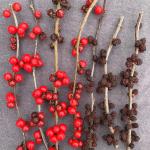 Fruit rot of winterberry (Ilex verticillata) caused by Colletotrichum. Commercial field of mature plants with branches harvested for winter displays. This fall, scattered berries began to shrivel and become a dull, reddish-brown (see photo). These stand in stark contrast to the healthy, bright red berries and render the diseased branches unsalable. Colletotrichum is known to cause a fruit rot of winterberry and other growers have suffered losses from the disease in previous years. While this pathogen can also attack the foliage and stems, there was no evidence of stem cankering from the submitted branches.
Fruit rot of winterberry (Ilex verticillata) caused by Colletotrichum. Commercial field of mature plants with branches harvested for winter displays. This fall, scattered berries began to shrivel and become a dull, reddish-brown (see photo). These stand in stark contrast to the healthy, bright red berries and render the diseased branches unsalable. Colletotrichum is known to cause a fruit rot of winterberry and other growers have suffered losses from the disease in previous years. While this pathogen can also attack the foliage and stems, there was no evidence of stem cankering from the submitted branches.
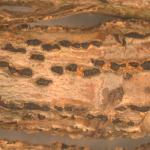 Stem and branch cankering of Japanese maple (Acer palmatum) caused by Botryosphaeria. Tree is 20-years-old and has been present at the site for ten years. The tree is part of a highly managed foundation planting, which includes many perennials, shrubs and ground cover plants. Regular irrigation is provided and the setting includes partial shade and good drainage. Verticillium wilt was suspected but there was no evidence the pathogen was present. Botryosphaeria was abundant on the submitted stems and numerous fruiting bodies were present after incubation (see photo).
Stem and branch cankering of Japanese maple (Acer palmatum) caused by Botryosphaeria. Tree is 20-years-old and has been present at the site for ten years. The tree is part of a highly managed foundation planting, which includes many perennials, shrubs and ground cover plants. Regular irrigation is provided and the setting includes partial shade and good drainage. Verticillium wilt was suspected but there was no evidence the pathogen was present. Botryosphaeria was abundant on the submitted stems and numerous fruiting bodies were present after incubation (see photo).
- Powdery mildew of red twig dogwood (Cornus sericea) caused by Erysiphe pulchra. One of several young dogwoods planted in a foundation bed along a well-traveled sidewalk. The site includes partial shade and drip irrigation. Symptoms of the disease included marginal leaf curling, leaf dieback and premature shedding. Dogwood powdery mildew was common this year on a variety of landscape dogwoods.
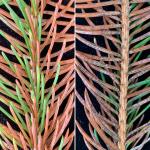
 Needle browning and premature shedding on a mature Norway spruce (Picea abies) caused by Lophodermium piceae. The tree is approximately 35’ tall with a dbh of 20” and resides in a dense residential neighborhood with full sun and sandy soils. Needle yellowing/browning and shedding was visible on interior portions of the canopy, which is typical of spruce needle blights. Lophodermium piceae was observed after a brief incubation of the needles. Infections result in the formation of black, transverse bands and rounded, swelling blisters on the needles (see photos). In autumn, these blisters rupture but do not release infective spores. Instead, spores are produced from larger pads of fungal tissue in the spring and spread via wind and rain. Drought stress is not suspected as a predisposing stress, as other nearby plants and turfgrass appeared healthy.
Needle browning and premature shedding on a mature Norway spruce (Picea abies) caused by Lophodermium piceae. The tree is approximately 35’ tall with a dbh of 20” and resides in a dense residential neighborhood with full sun and sandy soils. Needle yellowing/browning and shedding was visible on interior portions of the canopy, which is typical of spruce needle blights. Lophodermium piceae was observed after a brief incubation of the needles. Infections result in the formation of black, transverse bands and rounded, swelling blisters on the needles (see photos). In autumn, these blisters rupture but do not release infective spores. Instead, spores are produced from larger pads of fungal tissue in the spring and spread via wind and rain. Drought stress is not suspected as a predisposing stress, as other nearby plants and turfgrass appeared healthy.- Severe infestation of the cryptomeria scale (Aspidiotus cryptomeriae) on a specimen Fraser fir (Abies fraseri). The tree is roughly 20-years-old and was planted 11 years ago. The site includes full sun and well-drained, sandy soils. The tree has performed well since planting but this fall, canopy thinning and needle browning on interior branches was observed. The submitted sample exhibited chlorotic mottling on the upper surface of the needle with a large population of adult scales adhered to the underside of the needles. Infestations of the cryptomeria scale are slowly, but steadily, increasing in the region. True firs should be scouted regularly for armored scales, to catch infestations before they become serious.
- Foliar anthracnose of Bradford pear (Pyrus calleryana) caused by Colletotrichum. Tree is approximately 40-years-old and resides in full sun in a mulched bed behind a home. While the upper canopy receives full sun, the lower canopy is partially shaded. This summer, the foliage developed large, black-colored spots and blotches. There were no symptoms or signs of fire blight on the sample and the anthracnose pathogen was abundant at the leaf base and petiole.
- Canopy thinning and dieback in a Norway spruce (Picea abies) due to multiple pests and pathogens. The tree was planted in the late 1800s and has held the title of Vermont state champion for the species. It resides at the base of a hill next to a compacted, dirt driveway. Landscape edging was installed roughly 40 years ago next to the tree, badly damaging several primary roots near the flare. As a result, internal decay developed in the lower trunk and fleshy, annual fruiting bodies of the fungal pathogen Climacocystis borealis have been observed for many years. In the canopy, infestations of the Norway spruce gall midge (Piceacecis abietiperda), spruce bud scale (Physokermes piceae) and spruce spider mite (Oligonychus ununguis) were all detected. In addition, Rhizosphaera needle cast and Botryosphaeria stem cankering were also present.
- Leaf browning of boxwood due to a severe infestation of the boxwood mite (Eurytetranychus buxi). Multiple species and cultivars of boxwood from a variety of properties. Symptoms of the infestation included yellowing and browning leaves and flecking on the upper leaf surface. All of the plants are cared for regularly and reside in good soils with irrigation during extended dry periods. Between summer and fall, serious leaf browning developed in the canopy of several plants. The browning was more typical of winter injury on boxwood but the mite infestations were extensive on most samples.
Report by Nick Brazee, Plant Pathologist, UMass Extension Plant Diagnostic Lab, UMass Amherst.
Insects
Did you miss the live broadcasts of UMass Extension’s Invasive Insect Webinar Series? No problem! View the archived recordings of all seven webinars here:https://ag.umass.edu/landscape/education-events/invasive-insect-webinars
Interested in learning more about insect identification and life cycles? Only have 3 minutes or less? Check out InsectXaminer! https://ag.umass.edu/landscape/education-events/insectxaminer
Another year of the Landscape Message has come to an end. While 2020 has been different in so many ways, we still experienced familiar interactions with insect pests of trees and shrubs this season (even if some of the pests were new). Winter is a great time to review your monitoring and management records from the 2020 season, in preparation for planning for 2021. What worked well? What didn’t? What pest problems can you anticipate again in 2021 based on past trends? These questions can help you plan a new season of monitoring, communication with clients, and potential management solutions.
We hope to see you back with the Landscape Message again in 2021! Have a restful, fun, and safe holiday season!
Insects and Other Arthropods of Public Health Concern:
- Deer Tick/Blacklegged Tick: Check out the archived FREE TickTalk with TickReport webinars available here:https://ag.umass.edu/landscape/education-events/ticktalk-with-tickreport-webinars . Previous webinars including information about deer ticks and associated diseases, ticks and personal protection, and updates from the Laboratory of Medical Zoology are archived at the link above.
The next live webinar will be held on December 9, 2020 – More Ticks in More Places; A conversation with Dr. Tom Mather aka “The Tick Guy” - Speaker: Dr. Tom Mather, TickEncounter
The final TickTalk of 2020 will feature a conversation between host Dr. Stephen Rich and his guest Dr. Tom Mather. Dr. Mather will talk about “More Ticks in More Places” and discuss his highly regarded TickEncounter web site and associated resource center. Dr. Mather is a world-renowned tick expert who has also spent more than a decade bringing his expertise into the public conversation. Dr. Mather discusses the challenges of educating the public about ticks and tick-borne disease in an internet-savvy world where competing messages of questionable veracity can be found in abundance. Join Dr. Mather for an online tour of the TickEncounter web site (including TickSpotters), and hear stories of what happens when people are “just wrong enough” in their understanding of ticks and risk of tick-borne disease. Register at: Register at: https://attendee.gotowebinar.com/register/2502047964154713345
From October until roughly May, as long as daytime temperatures remain above freezing, adult male and female deer ticks (Ixodes scapularis) can be active, even in the winter. It is important to protect yourself against ticks and be especially vigilant for tiny, difficult to see nymphs. For images of all deer tick life stages, along with an outline of the diseases they carry, visit: http://www.tickencounter.org/tick_identification/deer_tick
Anyone working in the yard and garden should be aware that there is the potential to encounter deer ticks. The deer tick or blacklegged tick can transmit Lyme disease, human babesiosis, human anaplasmosis, and other diseases. Preventative activities, such as daily tick checks, wearing appropriate clothing, and permethrin treatments for clothing (according to label instructions) can aid in reducing the risk that a tick will become attached to your body. If a tick cannot attach and feed, it will not transmit disease. For more information about personal protective measures, visit: http://www.tickencounter.org/prevention/protect_yourself
Have you just removed an attached tick from yourself or a loved one with a pair of tweezers? If so, consider sending the tick to the UMass Laboratory of Medical Zoology to be tested for disease causing pathogens. To submit a tick to be tested, visit: https://www.tickreport.com/ and click on the blue “Order a TickReport” button. Results are typically available within 3 business days, or less. By the time you make an appointment with your physician following the tick attachment, you may have the results back from TickReport to bring to your physician to aid in a conversation about risk.
The UMass Laboratory of Medical Zoology does not give medical advice, nor are the results of their tests diagnostic of human disease. Transmission of a pathogen from the tick to you is dependent upon how long the tick had been feeding, and each pathogen has its own transmission time. TickReport is an excellent measure of exposure risk for the tick (or ticks) that you send in to be tested. Feel free to print out and share your TickReport with your healthcare provider.
Woody ornamental insect and non-insect arthropod pests to consider, a selected few:
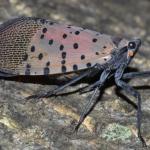


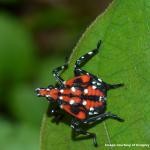 Spotted Lanternfly: (Lycorma delicatula, SLF) is not known to be established in Massachusetts landscapes at this time. However, due to the great ability of this insect to hitchhike using human-aided movement, it is important that we remain vigilant in Massachusetts and report any suspicious findings. Spotted lanternfly reports can be sent here:https://massnrc.org/pests/slfreport.aspx
Spotted Lanternfly: (Lycorma delicatula, SLF) is not known to be established in Massachusetts landscapes at this time. However, due to the great ability of this insect to hitchhike using human-aided movement, it is important that we remain vigilant in Massachusetts and report any suspicious findings. Spotted lanternfly reports can be sent here:https://massnrc.org/pests/slfreport.aspx
On September 25, 2020 the Massachusetts Department of Agricultural Resources (MDAR) urged Massachusetts residents to report signs of the invasive spotted lanternfly (Lycorma delicatula). They announced the finding of two dead specimens of SLF in Massachusetts communities, and are urging residents to report any sign of the invasive pest. The specimens were recovered in the towns of Milford and Norwood, and were brought into Massachusetts on materials shipped from Pennsylvania counties currently under a spotted lanternfly quarantine. Additionally, according to the September 25, 2020 press release, MDAR was recently notified that nursery stock with spotted lanternfly egg masses and adults may have been unintentionally imported and planted in several parts of Massachusetts.
MDAR is urging anyone who has received goods or materials, such as plants, landscaping materials, or outdoor furniture, from a state with a known SLF infestation to carefully check the materials, including any packaging, for signs of spotted lanternfly. Currently, there are known introductions of SLF in Connecticut, Delaware, Maryland, New Jersey, New York, Pennsylvania, Virginia, and West Virginia. For more information about this most recent press release, please visit:https://www.mass.gov/news/state-agricultural-officials-urge-residents-to-report-signs-of-invasive-spotted-lanternfly
Because no live lanternflies have, as of this press release, been found in Massachusetts, there is currently no evidence that SLF has become established in the Commonwealth. As a precaution, MDAR has planned surveys in the areas where the insects were found, to confirm that no live populations are present. While a dead lanternfly was previously found in the Boston area, in December of 2018, repeated surveys have found no further signs of SLF in that part of the state.
For a map of known, established populations of SLF as well as detections outside of these areas where individual finds of spotted lanternfly have occurred (but no infestations are present), visit: https://nysipm.cornell.edu/environment/invasive-species-exotic-pests/spotted-lanternfly/ This map depicts an individual detection of spotted lanternfly at a private residence in Boston, MA that was reported by the MA Department of Agricultural Resources on February 21, 2019. More information about this detection in Boston, where no established infestation was found, is provided here:https://www.mass.gov/news/state-agricultural-officials-urge-residents-to-check-plants-for-spotted-lanternfly
This insect is a member of the Order Hemiptera (true bugs, cicadas, hoppers, aphids, and others) and the Family Fulgoridae, also known as planthoppers. The spotted lanternfly is a non-native species first detected in the United States in Berks County, Pennsylvania and confirmed on September 22, 2014.
The spotted lanternfly is considered native to China, India, and Vietnam. It has been introduced as a non-native insect to South Korea and Japan, prior to its detection in the United States. In South Korea, it is considered invasive and a pest of grapes and peaches. The spotted lanternfly has been reported feeding on over 103 species of plants, according to new research (Barringer and Ciafré, 2020) and when including not only plants on which the insect feeds, but those that it will lay egg masses on, this number rises to 172. This includes, but is not limited to, the following: tree of heaven (Ailanthus altissima) (preferred host), apple (Malus spp.), plum, cherry, peach, apricot (Prunus spp.), grape (Vitis spp.), pine (Pinus spp.), pignut hickory (Carya glabra), sassafras (Sassafras albidum), serviceberry (Amelanchier spp.), slippery elm (Ulmus rubra), tulip poplar (Liriodendron tulipifera), white ash (Fraxinus americana), willow (Salix spp.), American beech (Fagus grandifolia), American linden (Tilia americana), American sycamore (Platanus occidentalis), big-toothed aspen (Populus grandidentata), black birch (Betula lenta), black cherry (Prunus serotina), black gum (Nyssa sylvatica), black walnut (Juglans nigra), dogwood (Cornus spp.), Japanese snowbell (Styrax japonicus), maple (Acer spp.), oak (Quercus spp.), and paper birch (Betula papyrifera).
The adults and immatures of this species damage host plants by feeding on sap from stems, leaves, and the trunks of trees. In the springtime in Pennsylvania (late April - mid-May) nymphs (immatures) are found on smaller plants and vines and new growth of trees and shrubs. Third and fourth instar nymphs migrate to the tree of heaven and are observed feeding on trunks and branches. Trees may be found with sap weeping from the wounds caused by the insect’s feeding. The sugary secretions (excrement) created by this insect may coat the host plant, later leading to the growth of sooty mold. Insects such as wasps, hornets, bees, and ants may also be attracted to the sugary waste created by the lanternflies, or sap weeping from open wounds in the host plant. Host plants have been described as giving off a fermented odor when this insect is present.
Adults are present by the middle of July in Pennsylvania and begin laying eggs by late September and continue laying eggs through late November and even early December in that state. Adults may be found on the trunks of trees such as the tree of heaven or other host plants growing in close proximity to them. Egg masses of this insect are gray in color and look similar in some ways to gypsy moth egg masses.
Host plants, bricks, stone, lawn furniture, recreational vehicles, and other smooth surfaces can be inspected for egg masses. Egg masses laid on outdoor residential items such as those listed above may pose the greatest threat for spreading this insect via human aided movement.
For more information about the spotted lanternfly, visit this fact sheet: https://ag.umass.edu/landscape/fact-sheets/spotted-lanternfly

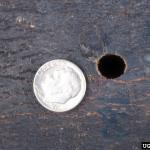
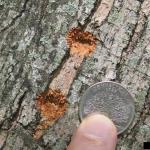 Asian Longhorned Beetle: (Anoplophora glabripennis, ALB) is a serious invasive insect that was first detected in Massachusetts in August of 2008. ALB was detected for the first time in South Carolina in 2020. Asian longhorned beetle eradication programs currently exist in Massachusetts, New York, and Ohio. A homeowner is responsible for finding, reporting, and making officials aware of the infestation in South Carolina. Great job!
Asian Longhorned Beetle: (Anoplophora glabripennis, ALB) is a serious invasive insect that was first detected in Massachusetts in August of 2008. ALB was detected for the first time in South Carolina in 2020. Asian longhorned beetle eradication programs currently exist in Massachusetts, New York, and Ohio. A homeowner is responsible for finding, reporting, and making officials aware of the infestation in South Carolina. Great job!
The U.S. Department of Agriculture’s (USDA) Animal and Plant Health Inspection Service (APHIS) and the Clemson University’s Department of Plant Industry (DPI) are inspecting trees in Hollywood, South Carolina following the detection and identification of the Asian longhorned beetle (ALB).
On May 29, a homeowner in Hollywood, South Carolina contacted DPI to report they found a dead beetle on their property and suspected it was ALB. A DPI employee collected the insect the same day and conducted a preliminary survey of the trees on the property. Clemson’s Plant and Pest Diagnostic Clinic provided an initial identification of ALB, and on June 4, APHIS’ National Identification Services confirmed the insect. On June 11, APHIS and DPI inspectors confirmed that one tree on the property is infested, and a second infested tree was found on an adjacent property. For more information, visit: https://www.aphis.usda.gov/aphis/newsroom/stakeholder-info/sa_by_date/sa-2020/sa-06/alb-sc . A recently released “Draft Environmental Assessment for the Asian Longhorned Beetle Eradication Program in Charleston, Dorchester, and Colleton Counties in South Carolina” from the USDA-APHIS provides a map of the currently known infested trees in that location. For more information, visit:https://www.aphis.usda.gov/aphis/newsroom/federal-register-posts/sa_by_date/sa-2020/alb-draft-ea
This is a good reminder for us to remain vigilant, and report any suspicious damage to trees, especially maples. Asian longhorned beetle infests 12 genera of trees, however maples are preferred hosts.
Look for signs of an ALB infestation which include perfectly round exit holes (about the size of a dime), shallow oval or round scars in the bark where a female has chewed an egg site, or sawdust-like frass (excrement) on the ground nearby host trees or caught in between branches. Be advised that other, native insects may create perfectly round exit holes or sawdust-like frass, which can be confused with signs of ALB activity.
The regulated area for Asian longhorned beetle is 110 miles2 encompassing Worcester, Shrewsbury, Boylston, West Boylston, and parts of Holden and Auburn. If you believe you have seen damage caused by this insect, such as exit holes or egg sites, on susceptible host trees like maple, please call the Asian Longhorned Beetle Eradication Program office in Worcester, MA at 508-852-8090 or toll free at 1-866-702-9938.
To report an Asian longhorned beetle find online or compare it to common insect look-alikes, visit: http://massnrc.org/pests/albreport.aspx or https://www.aphis.usda.gov/pests-diseases/alb/report
More information can be found in the “Trouble Maker of the Month” section of July’s edition of Hort Notes:https://ag.umass.edu/landscape/newsletters/hort-notes/hort-notes-2020-vol-315

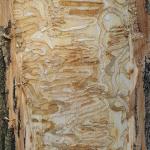
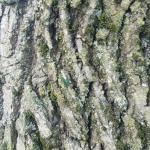
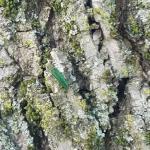 Emerald Ash Borer: (Agrilus planipennis, EAB) As of October 30, 2020, the Massachusetts Department of Conservation and Recreation has confirmed a total of at least 161 communities in Massachusetts that have known populations of emerald ash borer, 62 of which have been found in 2020. An updated map of these locations across the state may be found here:https://ag.umass.edu/fact-sheets/emerald-ash-borer
Emerald Ash Borer: (Agrilus planipennis, EAB) As of October 30, 2020, the Massachusetts Department of Conservation and Recreation has confirmed a total of at least 161 communities in Massachusetts that have known populations of emerald ash borer, 62 of which have been found in 2020. An updated map of these locations across the state may be found here:https://ag.umass.edu/fact-sheets/emerald-ash-borer
This wood-boring beetle readily attacks ash (Fraxinus spp.) including white, green, and black ash and has also been found developing in white fringe tree (Chionanthus virginicus) and has been reported in cultivated olive (Olea europaea). Adult insects of this species will not be present at this time of year. Signs of an EAB infested tree may include (at this time) D-shaped exit holes in the bark (from adult emergence in previous years), “blonding” or lighter coloration of the ash bark from woodpecker feeding (chipping away of the bark as they search for larvae beneath), and serpentine galleries visible through splits in the bark, from larval feeding beneath. Positive identification of an EAB-infested tree may not be possible with these signs individually on their own.
For further information about this insect, please visit: https://ag.umass.edu/fact-sheets/emerald-ash-borer . If you believe you have located EAB-infested ash trees, particularly in an area of Massachusetts not identified on the map provided, please report here: http://massnrc.org/pests/pestreports.htm
- Fall Home-Invading Insects: Various insects, such as ladybugs, boxelder bugs, seedbugs, and stink bugs have already found overwintering shelters in warm places, such as homes and other insulated buildings. To deal with any that have found their way indoors, simply vacuum them up – but be sure to empty the vacuum or remove and dispose of the collection bag before returning the vacuum to its storage location.
Concerned that you may have found an invasive insect or suspicious damage caused by one? Need to report a pest sighting? If so, please visit the Massachusetts Introduced Pests Outreach Project: http://massnrc.org/pests/pestreports.htm
A note about Tick Awareness: deer ticks (Ixodes scapularis), the American dog tick (Dermacentor variabilis), and the lone star tick (Amblyomma americanum) are all found throughout Massachusetts. Each can carry their own complement of diseases. Anyone working in tick habitats (wood-line areas, forested areas, and landscaped areas with ground cover) should check themselves regularly for ticks while practicing preventative measures. Have a tick and need it tested? Visit the web page of the UMass Laboratory of Medical Zoology (https://www.tickreport.com/ ) and click on the blue Order a TickReport button for more information.
Reported by Tawny Simisky, Extension Entomologist, UMass Extension Landscape, Nursery, & Urban Forestry Program
Additional Resources
Pesticide License Exams - The MA Dept. of Agricultural Resources (MDAR) is holding exams for new exam applicants. Space is still limited; to register, go to: https://www.mass.gov/pesticide-examination-and-licensing.
To receive immediate notification when the next Landscape Message update is posted, join our e-mail list or follow us on Facebook and Twitter.
For a complete listing of upcoming events, see our upcoming educational events https://ag.umass.edu/landscape/upcoming-events
For commercial growers of greenhouse crops and flowers - Check out UMass Extension's Greenhouse Update website
For professional turf managers - Check out Turf Management Updates
For home gardeners and garden retailers - Check out our home lawn and garden resources. UMass Extension also has a Twitter feed that provides timely, daily gardening tips, sunrise and sunset times to home gardeners at twitter.com/UMassGardenClip
Diagnostic Services
UMass Soil and Plant Nutrient Testing Laboratory:
Routine soil analysis and particle size analysis ONLY (no other types of soil analyses available at this time):
Turn-around Time Notice for November and December
Lab staff have two weeks of furlough, in addition to holiday breaks, coming up in November and December. Because our staff is so small, our most efficient option is to close the lab for the following periods: November 26 through December 4 and December 14 through January 1. To manage expectations, we are projecting completion dates as follows:
- Samples received in the lab by November 6 should be complete by November 25.
- Samples received in the lab by November 13 should be completed by December 11.
- Samples received in the lab after November 13 will be processed in order of arrival and may be completed by December 11, but most will be completed in January as soon as possible after the staff’s return to a normal work schedule.
Please plan for the fact that date of receipt in the lab is affected by weekends, holidays, shipping time, and time for UMass Campus Mail to deliver samples to the lab. Campus Mail delivery only takes place on Monday, Wednesday, and Friday due to pandemic restrictions.
UMass Laboratory Diagnoses Landscape and Turf Problems - The UMass Extension Plant Diagnostic Lab is available to serve commercial landscape contractors, turf managers, arborists, nurseries and other green industry professionals. It provides woody plant and turf disease analysis, woody plant and turf insect identification, turfgrass identification, weed identification, and offers a report of pest management strategies that are research based, economically sound and environmentally appropriate for the situation. Accurate diagnosis for a turf or landscape problem can often eliminate or reduce the need for pesticide use. For sampling procedures, detailed submission instructions and a list of fees, see Plant Diagnostic Laboratory
Soil and Plant Nutrient Testing - The University of Massachusetts Soil and Plant Nutrient Testing Laboratory is located on the campus of The University of Massachusetts at Amherst. Testing services are available to all. The function of the Soil and Plant Nutrient Testing Laboratory is to provide test results and recommendations that lead to the wise and economical use of soils and soil amendments. For complete information, visit the UMass Soil and Plant Nutrient Testing Laboratory web site. Alternatively, call the lab at (413) 545-2311.
Ticks are active any time that temperatures are above freezing! Remember to take appropriate precautions when working and playing outdoors, and conduct daily tick checks. UMass tests ticks for the presence of Lyme disease and other disease pathogens. Learn more